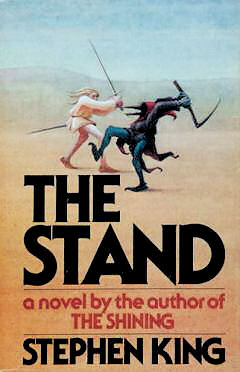The Stand is a sprawling narrative following a wide cast of characters during the outbreak of a superflu pandemic in 1990’s America. It is one of King’s longest stories (the unabridged version is nearly 1200 pages), but certainly not a slog. The Stand explores both the depths of human depravity and the heights of human compassion in an epic good vs evil battle both internally and across post-apocalyptic America.
It should be noted that I read this story in the midst of the COVID-19 pandemic of 2020, and there were a lot of eerie parallels to be drawn at the time. People living in a post-pandemic America may not remember, but prior to COVID-19 Americans had a unique distance to world problems. Not that nothing ever happened here, but there was an unspoken but common knowledge that war, famine, and disease are all things that only really happen in third world countries far across the ocean. Most Americans just took it for granted that if a fast-spreading virus were to pop up somewhere in the world, the CDC would have it covered. Military quarantine would stop contagion spread early, and our world class medical facilities would be able to handle anyone that was missed. Mass death due to disease is something that has happened in US history, but the idea was that medicine has come so far that nothing like that could ever happen to us. I remember telling my sister in the mid-February that even if it did reach US shores, the CDC would have it covered and it wouldn’t spread far. Not only was I wrong, but we now know that it had spread across large swathes of the US by that point, and our government didn’t know it yet but it had already failed on a level not seen in decades, and in a way that fundamentally altered American exceptionalism. The massive government incompetence both in real life and in The Stand was eerie to watch in tandem.
The early book has you flipping pages and going “my god, it cannot get any worse” and then consistently being proved wrong. Even after the superflu stops killing, things just continue to spiral downwards on a trajectory you think can’t possibly end in any other place than human extinction and the rule of evil. You know that the superflu has to keep spreading and that the eventual post-apocalyptic world isn’t reached through sunshine and roses, but that just adds to the suspense and dread of the initial fall. The characters with the most screen time are the popular musician Larry Underwood, the mute Nick Andros, the young and pregnant Frances Goldsmith, the average joe Stu Redman, and the anti-Christ like Randall Flagg (AKA the Dark Man, the Tall Man, and the Walkin’ Dude). King often describes events at the macro scale as well as swaps between the perspectives of these characters and the people around them as they traverse post-apocalyptic America.
This book is considered by many to be one of King’s best novels, and it often included in lists of best books of all time. Despite the long character list (literally dozens), they are all unique and dynamic characters who come experience profound personal growth throughout the events of the story. Despite the fantastical elements present in the story, many of the events and their resolutions come across as not only plausible but realistic. Structurally and narratively, I consider this book a masterpiece for at least the first half of the story. My one criticism is that things do slow down near the middle as everything begins coming together too fluidly, but King is able to accelerate the story in a leap that reengages the reader and brings a satisfying ending.
--Luke Melander

